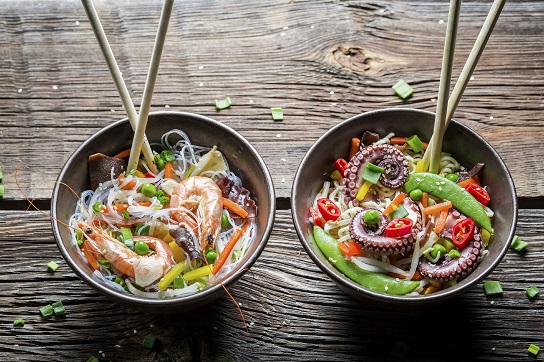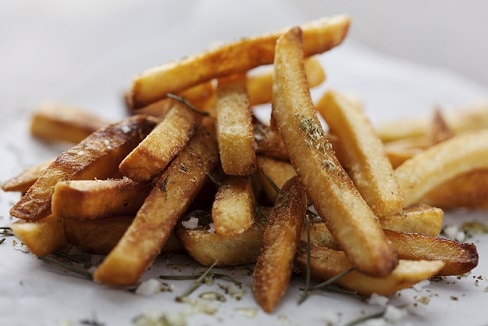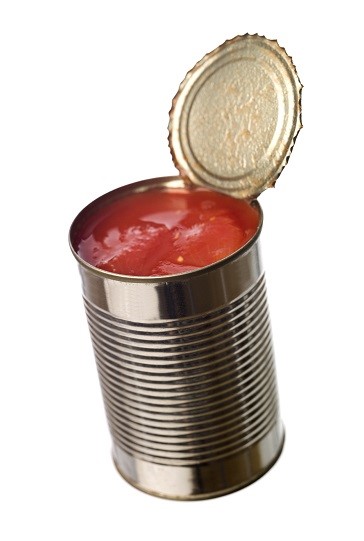 MSG (monosodium glutamate) is a flavour enhancer found everywhere in common processed foods, and it’s one of the most feared food additives of all time.
MSG (monosodium glutamate) is a flavour enhancer found everywhere in common processed foods, and it’s one of the most feared food additives of all time.
It’s got a terrible reputation in the mass media and in natural health groups, with its opponents blaming MSG in foods for Alzheimer’s, migraines, fatigue, stomach pain, central nervous system damage, Chinese Food Syndrome, weird feelings in the brain, and other forms of cognitive degradation.
Meanwhile, MSG manufacturers and the FDA say that MSG is harmless, that the allegations of brain problems have never been proven, and that MSG is simply an extract of naturally occurring glutamic acid which comprises 4.4 pounds of human body weight anyway.
Calls to ban MSG are intensifying and as you’d expect, acne patients on message boards are wondering if secret MSG lurking in food is actually behind their pimples. Many report long-lasting reductions in acne by eliminating MSG. Could they be imagining it or is MSG a real villain after all?
The truth is that your face won’t explode with pimples from a single bite of MSG, but MSG can insidiously cause acne by messing with your gut health.
What is MSG?
 Monosodium glutamate is basically a manmade derivative of the common amino acid or protein glutamic acid. Glutamic acid is a non-essential amino acid, meaning your body can manufacture it itself. In moderation, it’s critical for health; the average human has 4.4 pounds of glutamine in their body and it’s the key ingredient of many proteins, tissues and peptides. Glutamic acid also acts as a neurotransmitter to send impulses through your central nervous system.
Monosodium glutamate is basically a manmade derivative of the common amino acid or protein glutamic acid. Glutamic acid is a non-essential amino acid, meaning your body can manufacture it itself. In moderation, it’s critical for health; the average human has 4.4 pounds of glutamine in their body and it’s the key ingredient of many proteins, tissues and peptides. Glutamic acid also acts as a neurotransmitter to send impulses through your central nervous system.
For those reasons, there are numerous glutamine receptors around your body, including in your brain.
These receptors are also in your tongue and by stimulating them glutamic acid provides the fifth taste receptor in humans, dubbed “unami” by the Japanese.
The MSG story began in traditional Japan. Asian cultures used seaweeds like Kombu for centuries in meats and soups. For years, Japanese scientists attempted to identify the flavouring compound. Then in 1907, a Japanese chemist called Kikunae Ikeda was experimenting with various food flavours to find the ultimate combination, and isolated glutamic acid from seaweed. He found that Kombu provided its pleasing flavour by being extraordinarily high in glutamic acid, as did other foods like wheat, beets and corn.
Read Annihilate Your Acne – learn to prevent acne and stop just treating it!
Naturally this gave him a good business idea. He teamed up with a partner to create an artificial extract and in 1909 MSG was born. The Ajinomoto Corporation of Japan patented a glutamate extract as monosodium glutamate and sold it in the U.S. as Accent, the original MSG flavour enhancer.
So that’s how MSG originally kicked off, but what exactly is it? What it isn’t is naturally occurring glutamic acid.
The natural form from Kombu and other whole foods is L-glutamic acid, a form which is naturally bound to other amino acids and peptides. Glutamic acid causes the same problems as MSG when overdosed on, but that’s difficult to achieve. Your body has to break down or hydrolyse glutamic in the stomach and lower intestines using hydrochloric acid and digestive enzymes. The digestion is easily adjusted accordingly to how much l-glutamic acid you actually need. Excess glutamine is not stored by the body, it’s passed off as waste. Your body has a tight leash on glutamic acid from natural food.
…but with MSG it’s the opposite. Despite what many MSG manufacturers claim, MSG is not identical to glutamic acid from nature; it is d-glutamic acid, a free form which your body cannot easily control. In the chemical MSG manufacturing plant the bound glutamic acid is broken down and made free of protein. This is achieved through various processes; glutamic acid can be hydrolysed, autolyzed, modified or fermented with strong chemicals, acids, genetically modified bacteria, or enzymes.
It ends up as a refined white crystal powder which is digested extremely quickly, because there are no accompanying proteins and peptides to slow it down. It’s estimated that after consuming pure, manufactured MSG powder, your blood glutamine levels can increase by 8 to 10 fold.
Why MSG is a feared additive
 What happens next is what the media constantly warns about: MSG acts as an excitotoxin. The term “excitotoxicity” refers to overstimulation of nerve cells to the point where they collapse and cease functioning. In the case of MSG the massive stimulation of glutamine receptors in your tongue is what manufacturers want…
What happens next is what the media constantly warns about: MSG acts as an excitotoxin. The term “excitotoxicity” refers to overstimulation of nerve cells to the point where they collapse and cease functioning. In the case of MSG the massive stimulation of glutamine receptors in your tongue is what manufacturers want…
…but MSG also overstimulates the glutamine receptors elsewhere in the body, most famously in the brain.
MSG can bypass the protective brain blood barrier and wreak havoc in certain brain receptors. The result can be impaired thinking, brain fogginess, messed up thought processes, and possible neuronal degeneration.
MSG can also overstimulate the glutamine receptors elsewhere in the body. It was in 1959 that the U.S. Food and Drug Administration first labelled MSG as “Generally Recognized as Safe” (GRAS) a status which MSG still enjoys today. From that day forth it took only ten years for a condition known as “Chinese Restaurant Syndrome” to enter medical literature, which described numerous side effects ranging from numbness to heart palpitations to an inability to concentrate, that people developed after eating MSG.
Even the FDA, who maintains that MSG is harmless, has this to say:
- “Abnormal function of glutamate receptors has been linked with certain neurological diseases, such as Alzheimer’s disease and Huntington’s chorea. Injections of glutamate in laboratory animals have resulted in damage to nerve cells in the brain.”
The FDA also admits to the existence of a complex known as “MSG Symptom Complex”. Apparently, some people who eat MSG are likely to experience short term health effects like numbness, burning sensations, tingling, facial pressure or tightness, chest pain or difficulty breathing, headache, nausea, a rapid heartbeat, drowsiness, and weakness.
Studies from the 1970s suggested that 25% to 30% of the US population was intolerant to MSG levels found in food during that era. Now though, MSG has spread even further into the food supply. Foods that contain MSG include: sauces and seasonings, protein powders like whey protein (added MSG for flavour), nearly all restaurants and fast food chains, soy products, potato chips, similar potato snacks, and many more processed foods.
One estimate states that 40% of the population may be sensitive to MSG. There are positive stories of people quitting MSG everywhere. Many people struggle with the symptoms above, only to eliminate processed foods with MSG and be happy at finally removing the culprit which they couldn’t identify for years.
The top 6 vitamins and minerals for clearing acne forever
This study fed either MSG or a placebo to patients. 36.1% of patients reported negative side effects from MSG, compared to 24.6% for the placebo. Reported side effects included headache, muscle tightness, weakness, flushing, and numbness/tingling.
There isn’t evidence that eating a single dose of MSG will make your brain cells start dying en masse. Some of the fear tends to be exaggerated by natural health hippies and well-meaning people who have a hypersensitivity.
However, there’s plenty of evidence that excitotoxins like MSG can wreak havoc long term, and sensitivity is definitely real.
How MSG causes acne
 There are glutamine receptors all over your body, and that includes your gut and small intestine. Digestive health is intricately linked to acne…
There are glutamine receptors all over your body, and that includes your gut and small intestine. Digestive health is intricately linked to acne…
…and this study found that MSG could substantially worsen the symptoms of acne-related gut disorders like irritable bowel syndrome.
The results displayed here are very interesting. The scientists gathered some fibromyalgia patients who also had the inflammatory disease irritable bowel syndrome. For four weeks the patients were placed on an excitotoxin free diet which eliminated all sources of MSG. Of the patients who successfully followed the MSG free diet for 4 weeks, 31 out of 37 participants (84%) noticed a good improvement in their symptoms.
According to a questionnaire, the symptoms improved by over 30%. The study was double blind, which means that neither the scientists nor the participants knew which diet they were following. That’s a gold standard of scientific research.
Why does an improvement in gut problems help acne? Because such diseases are a little known cause of inflammation in the body and other diseases behind acne. Irritable bowel disease, for example, is linked to…
- Poor absorption of important nutrients for acne, such as zinc and magnesium.
- Increased rates of food allergies, which commonly cause acne.
- Leaky gut syndrome, an overlooked cause of acne.
- Damage to healthy gut bacteria.
Other digestive problems have similar effects on acne, whether it’s Crohn’s disease or moderately overactive inflammatory responses. Anecdotal evidence links MSG to gut problems as well; stomach pain and nausea are common stories.
Recommended – the 7 greatest natural topical treatments for acne
There are many glutamate receptors in your gut, and these may be overloaded to impair vital functions like acne nutrient absorption and inflammation regulation. Your brain and neurotransmitters also affect your gut health via the so-called “gut-brain axis”, so a disturbance in your emotions from MSG could also add those acne problems indirectly. That theory links in with
If eliminating MSG can lower digestive inflammation then that’s excellent news for acne. Again, some acne patients will be more sensitive to MSG than others. If you eat a lot of cheap protein, steak sauces, Chinese foods, potato chips and snacks or indeed a diet heavy in any processed foods, there’s a strong change that eliminating MSG will help your acne. The acne prospects are especially good if you have the digestive problems outlined above or other symptoms of MSG/excitotoxin sensitivity.
At the same time, you’ll eliminate a risk of Alzheimer’s disease, migraines, and every other horror that MSG is linked to. Remember that many of the studies cited by the FDA as evidence for MSG being totally harmless were funded by big MSG manufacturers.
The official stance that MSG is safe does not gel with the endless great stories of people eliminating it. If you ever noticed weird feelings in your brain or get tingling and brain fog after eating steak sauce, veggie burgers or other soy products, there’s a strong chance that MSG is the culprit.
How to avoid MSG
 The first fact to remember is that many lists of MSG containing foods on the internet mistakenly list foods with glutamic acid as well.
The first fact to remember is that many lists of MSG containing foods on the internet mistakenly list foods with glutamic acid as well.
For example: gelatin, a healthy food of condensed animal connective tissues, contains l-glutamine as one of its many amino acids (alongside proline and glycine). Many recommend avoiding gelatin to avoid MSG, but that’s absolute nonsense. The glutamine in gelatin is bound up with amino acids as well as many peptides and natural compounds. It is not equivalent to chemically processed MSG in a Chinese cracker.
Don’t instantly fall for scaremongering lists. Gelatin is a terrific food supplement for acne. Likewise, you shouldn’t worry about seaweeds, beetroot, tomatoes etc. The digestion is measured and they don’t spike your blood levels to dangerous levels.
Here are the sources of MSG you really need to worry about:
Fast food and restaurants – the inside information on MSG in fast food restaurants is too extensive to fully cover. Almost every major chain uses MSG in hidden names like yeast extract. That includes McDonalds, KFC, Pizza Hut and Burger King. Fast food is not healthy for acne anyway, so if you love them, make them a special treat. The exact same rules applies to regular restaurants, unless they’re very health orientated.
The following ingredients – these always or very commonly contain MSG. Glutamic Acid (E 620), glutamate (E 620), monosodium Glutamate (E 621), monopotassium Glutamate (E 622), calcium Glutamate (E 623), monoammonium Glutamate (E 624), magnesium Glutamate (E 625), natrium Glutamate, yeast extract, anything hydrolysed, any hydrolyzed protein, calcium casseinate, sodium casseinate, autolyzed yeast, textured protein, soy protein, soy protein concentrate, soy protein isolate, whey protein, whey protein concentrate, whey protein isolate, vetsin, ajinomoto.
Sea buckthorn oil – a topical treatment which lowers oily skin by 45%
As you can see, many of those are usually nutritious and heathy foods, like whey protein and casein. Any protein supplements are highly likely to contain MSG, so always check the label for MSG or “glutamate” or “hydrolysed”.
Soy products – vegie burgers, soy sauce, and soy protein are all suspicious MSG candidates. The reasoning is simply to improve the taste. Given that many soy products like veggie burgers are designed for vegans, it’s important for the customer to find an alternative to meat that’s actually palatable.
Steak sauces – yet again, simply added to improve taste. Unlike trans-fats, which the FDA plans to ban by 2017 and are reviled by most of the consumers, there’s no effort by corporations to remove MSG from their products. The FDA still says they’re safe. There are also so many options for disguising the name (see above).
Potato chips/snacks – generally, MSG is found in more savoury foods, because that is the flavour that the “umami” of the glutamate receptor blends well with. So potato based snacks are a prime candidate for MSG. Nearly all of them contain MSG unless not containing MSG is a specific guarantee. You’re less likely to find MSG in sweet candies, cakes and cookies but it’s still possible.
Starch ingredients – the type of thickener and flavour enricher you add to cakes, rolls and soups. Corn starch, maize starch, potato starch, and rice starch are all likely to be “enriched” with MSG.
Commercial soup mixes – another savoury ingredient. MSG will get you gobbling down commercial soups down like a maniac. The same applies to commercial spaghetti and pasta sauces. In fact, I always used to wonder why spaghetti Bolognese from a restaurant magically tastes so much better despite having no discernibly different ingredients to a homemade version. Clearly, the secret weapon is MSG.
Conclusion
MSG is not as conclusively linked to acne outbreaks as other food additives like the monstrously unhealthy trans-fat or added sugar. But what we have is preliminary scientific data that MSG messes with your digestive system, and a ton of anecdotal data that it does the same. I can easily recommend you to avoid MSG and its Chinese Food Syndrome and MSG Symptom Complex.
Furthermore, the debate about its safety is irrelevant considering that MSG is totally unnecessary to eat. If you’ve read this article then you’ll know that processed foods are full of acne-causing contaminants and sugars anyway. On an acne-friendly diet you will automatically eat less MSG. Personally, I’m avoiding MSG except for when I eat out at restaurants. MSG is a classic case of better safe than sorry.
You don’t need artificially made flavour enhancers to make food taste good. Great flavour is easily within your reach with a sprinkle of oregano, a tablespoon of cinnamon, some onions, garlic, or chopped avocado.
You get real rich flavour, not blunt overstimulation of one single taste receptor. Herbs and spices also offer great value for your acne, since they’re very high in antioxidants and other plant compounds.
Few consider eating cinnamon for acne, but it lowers insulin levels and hence oily skin superbly. The safest and tastiest natural flavourings for food are some of the most underestimated nutritional powerhouses.
NEXT: read the 167 page eBook and get the ultimate diet for acne
Thanks for reading!
